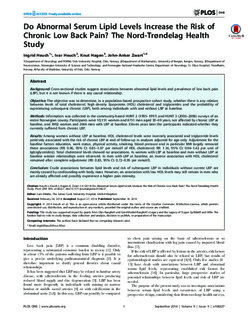Do abnormal serum lipid levels increase the risk of chronic low back pain? The Nord-Trøndelag Health Study
Abstract
Background: Cross-sectional studies suggest associations between abnormal lipid levels and prevalence of low back pain
(LBP), but it is not known if there is any causal relationship.
Objective: The objective was to determine, in a population-based prospective cohort study, whether there is any relation
between levels of total cholesterol, high density lipoprotein (HDL) cholesterol and triglycerides and the probability of
experiencing subsequent chronic (LBP), both among individuals with and without LBP at baseline.
Methods: Information was collected in the community-based HUNT 2 (1995–1997) and HUNT 3 (2006–2008) surveys of an
entire Norwegian county. Participants were 10,151 women and 8731 men aged 30–69 years, not affected by chronic LBP at
baseline, and 3902 women and 2666 men with LBP at baseline. Eleven years later the participants indicated whether they
currently suffered from chronic LBP.
Results: Among women without LBP at baseline, HDL cholesterol levels were inversely associated and triglyceride levels
positively associated with the risk of chronic LBP at end of follow-up in analyses adjusted for age only. Adjustment for the
baseline factors education, work status, physical activity, smoking, blood pressure and in particular BMI largely removed
these associations (RR: 0.96, 95% CI: 0.85–1.07 per mmol/l of HDL cholesterol; RR: 1.16, 95% CI: 0.94–1.42 per unit of
lg(triglycerides)). Total cholesterol levels showed no associations. In women with LBP at baseline and men without LBP at
baseline weaker relationships were observed. In men with LBP at baseline, an inverse association with HDL cholesterol
remained after complete adjustment (RR: 0.83, 95% CI: 0.72–0.95 per mmol/l).
Conclusion: Crude associations between lipid levels and risk of subsequent LBP in individuals without current LBP are
mainly caused by confounding with body mass. However, an association with low HDL levels may still remain in men who
are already affected and possibly experience a higher pain intensity.
